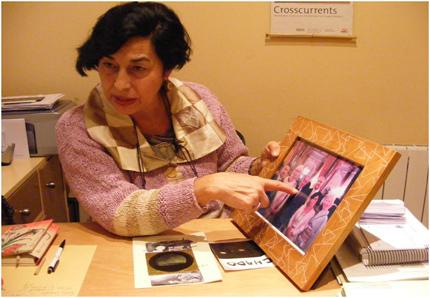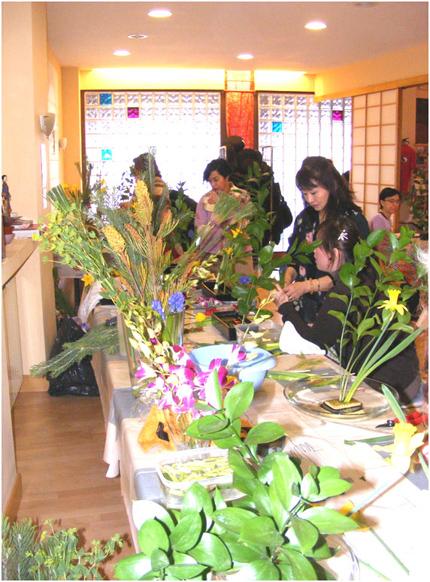Noticias previas
INTERVIEW WITH RITA LOZANO. ESPACIO ZEN CONTEMPORÁNEO
Espacio Zen Contemporáneo is one of the associations taking part in the organization of the festival “Nihon Jaia 2010”, event in which they will be present with some activities about japanese traditional culture. Located in Algorta, it has been 10 year of life in 2009, and one of his proposal is promote health understood as a physical, psychic, social and spiritual good that human must support for his own harmony. That’s the reason why Espacio Zen Contemporaneo reached a very important relevancy in the organization of courses when people initiates in Ikebana (生け花), Chadō (茶道),Tai Chi Chuan (太極拳) or Zen meditation.

Which are the origins of Espacio Zen?, What kind of activities you realize in the center? You told me once you were pioneering…
The idea of creating Espacio zen become by an ideal. When I was young, I read about Nobel Prize Yasunari Kawabata, “Thousand cranes” (1962), that book made me felt in love about japanese culture. From this charmed on, some years later, I started being interested in “Tea Art”. I collected items about tea and info in spite of the difficult of find anything those years. It was in New York when, in a Japanese Society Meeting, I could discover who the tea could be studied, respecting his origins but in a didactic way. Not only was Kawabata, but there was another Japanese authors as well, as Yukio Mishima and Haruki Murakami who have made me feel really loved by this culture. It’s something I have inside. By the other way, I am physical therapist then I worked with Tai-Chi related with my profession and I thought that it was important. That is another point that made me interested for Japanese culture.In my profession the important disclipines were Tai-Chi, meditation, and lately I studied all related to zen, as Tea ceremony, Ikebana, and so.. I felt the body as a limited material but I thought it should be more that a limited material, as there is not also a body but it is also a soul. So I started treatment from a different perspective, teaching to make the interior richer. I was inspired by Consuelo Martin my philosophy teacher, specialist in Advaita Vendata. I started the courses 30 years ago. They are silence courses, meditation, and I discovered in her words and meditation what I was inside. I had the physical therapist buffet and I thought I must create a new space opened to Zen. This way, combined my studies in Zen, and my daughter’s Psychology ones, we created Espacio Zen.
Actually the arts in Espacio Zen which come from zen are destined to open the mind. If it is success life is healthy. Silence is curative, stimulates you to develop and work from inside to outside. It must be mentioned that when Espacio Zen opened, this year will be ten years ago, Ikebana and Tea Ceremony was not as known here as today is.We contacted with Eiko Kishi and Yoko Konoshita, and they came to Espacio Zen since 10 years ago. We give certifications to our pupils, we promote exhibitions…, we try to make different activities where people can find itself.Because all Zen paths are a way of reach the state of mind. For a Japanese artist is not only the picture you made, but all the process to make it. In my case, I have always tried to reach the beauty of the perfection, the moment. I studied another Japanese concepts as Chadō and this made me reach to find my essence in tea ceremony.

Could you explain us Tea Ceremony? Which ritual or protocol must be followed during its execution?
Well, I must say that in spite I have always loved tea ceremony, I am not still a teacher or sensei. In fact, my intention of join Ura Senke School has been a difficult way which takes 15 years long. Yoko was my first teacher, buy it was a private activity more tan a didactic lesson. It was in New York were I was told and connected with a teacher in Madrid, Javier Martinez, he is one of the delegates of Ura Senke in Spain.(Rita shows us a photography in which she appears with some tea ceremony’s teachers) Genshitsu Sensei(Sen Soshitsu XV) is here, I and proud to be in this pics in a Convention in Rome 3 o 4 years ago. All teachers and people in Tea world came to Rome. To be a teacher you must give a serie of steps or levels progressively to reach the category or “tea teacher” (Tea sensei).
Tea ceremony is Chadō, what it means, it is the way to tea. It quite as a theatre representation. It starts when the guests coming, who have cross the Roji, What is the way where they have liberate themselves from all worries, hurries… Once you let that stressed world behind they came in in the tea house. It is usual that people don’t know themselves or the ceremony takes place when the seasons came. Ceremony can be taken because it is snowing, and we wish to see the snow, because a plum has bloomed and we go to admire those flowers, or even because a person, in past times more than nowadays, has created a haiku and he wants to show everybody else.
People related to literature, philosophy and arts took part often in Antique ceremonies, in which the sense of tea was very appreciated. But in XVI century Sen Rikyū (千利休) changed some points. He was an innovator and gave an aesthetic and new look to the ceremony, even the architecture of the tea houses ( I had the opportunity of meet an tea houses architect in Japan who showed us the antique houses and interiors. Sen Rikyū was an innovator in ceramics, clothing, steps of ceremony, protocols, changing deeply traditional ceremony.From this time on different tea schools were born, originated in his own Family. (Genshitsu y Soshitsu XVI are descendants of Sen Rikyū family). Nowadays, they are like Tea universities and his transmission and power (for example in diplomacy) in Japanese society is really big.Tea ceremony is, as Sen Rikyū says, boil the water, prepare the tea, and offer peace in a tea bowl. Everything giving attention, knowing the premises of reverence, purity and peacefulness. Doing it this way is neccessary, as Sen Soshitsu XVI says, to give peace in a tea bowl.The act is deeper, but in synthesis, the art of tea resumes in observing, purify your senses. There is a purification of objects, gestures, all senses thank to incienses, tact, ceramic sensation. There is purification as well in the fall of water, kei jaku movements or water spoon. After this purification of senses, master ( sensei) and guests must become an empty mind to observe the tea bowl inside this created ambient.

So, according on what you explain, let me know if I’m wrong, Chadō as an artistic and ceremonial expression is something appart from this world. Consequences extracted from it are diverse, but you in your medical profession, where do you think is the line of Chadō as a therapeutic function?
Look ( Rita shows a little book) I give these books I made myself, for those who came to tea ceremony. The intention is, after the tea ceremony, to read it carefully in their homes. Well, I have always empathize the relation between tea and health. In those pages I explain this drink is the clear and peaceful dew of the sky and no more, and taoists medics used them for his medicines and other functions.In this point of view, a philosophical one,tea ceremony offers the union between you body and your mind. A kind of union between mind, body and spirit, and a new space beyond the thought. We are in thought no more, in duality, we enter in a curative area as we have no necessities of worrying about anything else, good or evil. I see all the process as a witness, I see what it happens and that will surround me with serenity. If you calm down, your body is as well, your cells as well, they all smile as Taoists says.
Related this last words, have you managed to verify the therapeutic efficiency of a tea ceremony in your pupils or even yourself?
A therapeutic effect usually exist, but you must understand there is brief time doing tea ceremonies beyond the friends circle, but people usually say the have feel peace after ceremony.In this point I think nothing more can be told. Peace helps you, although it remains to conflict again. All those elements made us relaxing. I don’t like to use “relax” Word because the concept of the Word is not well defined in this case. I prefer to talk about a contemplative mind who makes your body and spirit rest in peace.
Those therapeutical properties can be found as well in another of the activities in Espacio Zen? I mean Ikebana and such.
Yes, there are some studies in psychology about ikebana. In fact, an ikebana teacher made different groups to study the effect of Ikebana and they checked out it was really beneficial.
¿Could you explain us a bit about Ikebana?
Ikebana is a flower art concept in japan. His origins are found in the three concepts: sky, human and Earth. With those concepts and with the different Ikebana Schools flowers are placed to form an harmony triangle. Flowers are combined according the seasons, colors, and schools. The intention of Ikebana is harmony as well.
For example, people come often very anxious, but slowly, I can see them become silent, and relax, listening to the teacher. Finally when they see what they have created they feel relaxed, in harmony. Our school, Misho-Ryu has an special composition Kakubana ( I will explain later) who reaches the perfect lines to harmony. You really don’t know what it happens, but suddenly the flowers placed made you feel surprised. Oh what beauty! The moment of beauty.

Ikebana follows a kind of ephemaral flower sculpture, I suppose there are some aesthetic points in composition.
Ikebana is an architecture, an sculpture. First you work by classical school with his basic rules and techniques which you must know. The first year is shown Misho-Ryu, the most traditional school. Misho-Ryu has the Kakubana compositions. You must dominate this technique if you want to learn new ones. With these techniques there is a free one, it has ikebana rules “sky, human, earth” but allows more liberty in the composition, as Nageire. First of all you must learn traditional school, and our teachers are very hard on it.
With your academic knowledges in Chadō, how do you value the importation of those arts in western culture? Is there a genuine approach or maybe a contamination with our own culture?
Let me see. Western essence is present in this kind of practices. But some people interest this art because, previously, liked this Eastern essence. This point makes the beginnings easier, as people has the knowledges and essence.
Other people are curious or they heard about it and try but usually the leave the learning. I think you must have something inside you to arrange and being interested in learning it. One day while we was in meditation lesson we talked about it. There must be something inside you, like a seed. This way people will understand this activity from deeper. Something different is the intention of adapting these kind of arts. I am not disappointed at all, although this way the essence uses to disappear.
So, according to that, there is some sort of reductionism, almost a choice selection of Far East (tradition, items, cultures...)
Well that is not good because the real essence of the art would be lost and this way it would have not sense at all. Anyway is, as you say, to do it your way. I don’ see this ok and I don’t like it at all. I think this intentions of mixture are like a mode and pass quickly in time. I really think you must go on with genuine concepts to make everything successfully.
Previously you have mentioned the relation between Chadō and some japanese writers as Y. Kawabata or Y. Mishima. I would like you to explain deeper the idea of japanese literature as a way to learn or get interested in those disciplines.
I am part of that generation who met Kawabata and his work “Thousand cranes”. This was the way for Japanese literature to approach to West. I have always liked reading, and that book made me feel the meaning of beauty and death. As I told you before I knew about japanese art because of my profession. I was nurse before studying physiotherapist, so i was in contact with illness and death. Moreover it was something I worried and even frightened me. When I read Kawabata, always writing about death and a person who gave the death a sense of beauty, I felt really shocked and I found something which followed me for a long time.I was about 24 years old when I read Kawabata, and this moment on I interested in death sense in Japanese literature. What it more, If you want to learn about Japaneses culture you must read writers as Kawabata or Mishima. In their thought the beauty of the moment is present, and the beauty is what is born and dead in every moment, ephemeral, not permanent. What they call ichi-go del ichi-e (一期一会). This memento does not repeat anymore.
This made me read more about japanese writes. I like H.Murakami very much, with his “The wind-up bird chronicle”. We can't forget either the haiku tradition, as Chadō is like a Haiku.
As you express it, must we understand haiku, Chadō , Ikebana as a different branches of the same concept?
That’s the way. Behind those different branches is present the Zen concept. Zen is deeply associated to Japanese culture.
Nowadays, is it possible to talk about Zen culture in technologic XXI century Japan?
Yes, in technology and even in economy. Zen influences the way even in modern Japanese life. That is the reason why they have successfully evolved from traditional to avant-garde (in which are pioneers) I think the have managed to get along very well, and even I think that there is a recovery of traditional. Perhaps there was a time, as we mentioned in a conversation before, in which young people forgot traditional arts studying as if were piano or guitar lessons. For example teachers in our center practices Ikebana and tea ceremony since they were 12 years old. Yes, there was a time, in which it was forgotten, but young people is now returning to assume traditional arts because they realized if they don't, they will lose their essence and culture.

From what perspective do you exercise pedagogical work of introducing the Western discipline the experience of ephemeral?
Immortality, continuity… people came gradually to Espacio Zen to practice Tai Chi or meditation. In meditation classes we often talk about it. Sometimes new people came and teachers tell them to remove a lovely ikebana composition. The first reaction is resistance: Why I should remove it, it’s beautiful!? The key is to understand precisely that you will get out nice again, the ephemeral is like the flower falls. People should understand this idea if not, life will let them down. Life is so! Watch this hurricane today ( our interview coincides with a hurricane in Euskadi’s coast) taking all, it moves everything… You have to adapt to this situations. I don’t get down. If a cliclone comes today, tomorrow the sun will shine, and the person who won’t understand this, will never understand the essence of life, it is a shame because maybe I had to learn it in another time.

In addition to the practice of Ikebana and Chado you carry out another specific activities of meditation, isn’t it?
We practice Zen, and Tai Chi everyday. It help to get a high grade of contemplation. We try this not to be taken as a technique to reach an specific objective. I Know meditation is on fashion now. I will meditate to feel better, to heal myself, to reach this or that. Well it is now that way. Meditation is not a technique, is nothing, it’s only get empty, forget whatever it avoids to understand what you are. We only meditate in that thinking. A meditation who reaches to human being and which is not reached between continuous noises.
You alluded earlier to the interests that motivate people to come to the center, but I would like to insist more on it. What kind of people came and what concerns? Is there a specific profile for each practices?
Yes. For example, people in a quest of themselves came to Tai Chi and meditation. And people with health problems, stress comes specially to Tai Chi because is a technique which helps to body, spine, and works on psycho-motor, and illness related to bones, osteoarthritis… Some of the people came recommended by their own doctors.
We would like to finish asking you about your long-term projects.
We have received a lot of proposals to introduce here multiple techniques but, from our point of view, this would changed our way of being and acting in Espacio zen. Our short-term idea is consolidate the activities we are developing now and share then to as many people.



